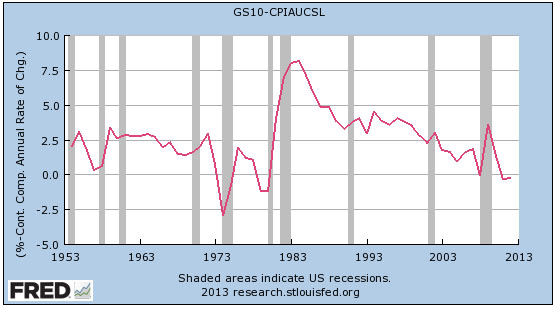Paul Krugman has an interesting post up today asking why we’ve had so many bubbles over the past few decades:
The answer you hear from a lot of people is that it’s all caused by excessively easy money. But let’s think about the longer-term history for a bit. Here’s long-term U.S. interest rates since the early 1950s.
What follows is a chart showing that 10-year treasury maturities went up from 1950-80 and then went down from 1980-2013. But it was pretty symmetrical: rates didn’t fall below their 50s/60s level until the mid-aughts. Historically speaking, the two eras were about the same, so easy money doesn’t seem like much of an explanation.
But isn’t it actually even more striking than that? Shouldn’t we look at real interest rates?1 Here’s a rough look at real 10-year maturities since 1950:

Real long-term interest rates during the past 30 years have been consistently higher than in the 50s and 60s. It wasn’t until 2008 that they fell noticeably below their 1950-1970 average. And yet, as Krugman says:
The whole era since around 1985 has been one of successive bubbles. There was a huge commercial real estate bubble (pdf) in the 80s, closely tied up with the S&L crisis; a bubble in capital flows to Asia in the mid 90s; the dotcom bubble; the housing bubble; and now, it seems, the BRIC bubble. There was nothing comparable in the 50s and 60s.
And don’t forget the Nordic property bubble of the early 90s. That’s a lot of bubbles. So if it wasn’t easy money, what was it? Krugman again:
So what was different? The answer seems obvious: financial deregulation, including capital account liberalization. Banks were set free — and went wild, again and again.
I’ll buy that up to a point. It’s not as if financial regulation can prevent bubbles entirely, but it can tame them. For the past 30 years, they’ve been running wild because we haven’t done anything to stop them. Maybe we should start.
1This is a real question. I’m actually not sure. I’m posting this partly in the hopes that if I’m wrong, someone will explain why.













